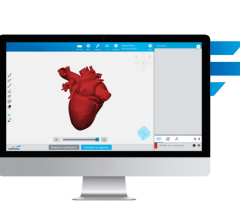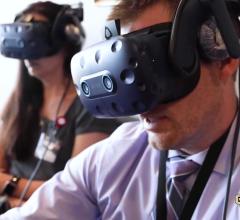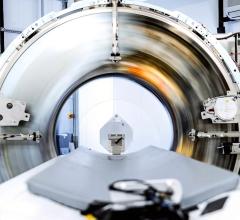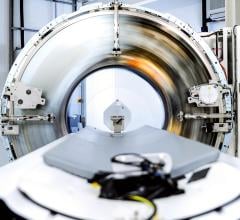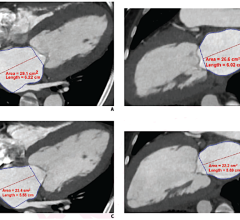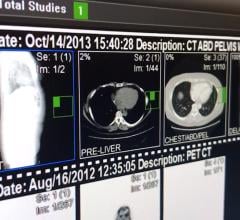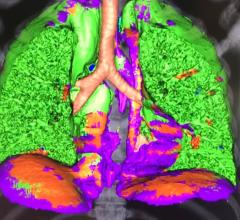
3D Rendering of a CTA. Image data captured via the Aquilion 16-slice CT from Toshiba America Medical Systems (Tustin, Calif) advanced visualization and analysis performed using Voxar 3D from Barco
As the volume of cardiovascular imaging procedures continues to grow, cardiology imaging IT is representing the fastest growth area for revenue among both the providers and vendors. Advanced imaging is also picking up in oncology, as the capabilities of imaging modalities advance. What we are seeing in medical imaging is that the clinical areas the providers are capitalizing on are also the main areas served by advanced visualization technology.
Although the market considerably slowed down in 2008, advanced visualization remains top-of-mind among late adopters of the technology, and heavy users of 3D imaging are currently contemplating the next upgrade to a more efficient platform. It follows that despite the apparent commoditization of 3D imaging technology and mounting pricing pressures, the large market potential creates a positive outlook on the market for the next few years as the technology continues to go mainstream. While market growth rates can continue to fluctuate as widely as they have in the last several fiscal quarters, they tend to be less subject to the sharp falls into the red that are taking place with capital imaging equipment such as CT and MR scanners. In addition, as has been the case during the last few years, the next phase in the market is expected to be characterized by significant dynamics of competition and collaboration between the industry vendors, with many more new R&D partnerships, co-marketing agreements, mergers and acquisitions… and litigation.
Where Do We Stand with PACS-3D Integration Today?
It is generally agreed that advanced visualization will ultimately become an integral component of the complete workflow system that PACS is continually evolving toward. There is indeed no rationale for handling a 3D/4D study any differently than standard studies, especially as the procedure mix evolves in favor of 3D imaging. In addition, 3D renderings are being utilized in an increasing number of clinical applications and across a widening array of care settings. The PACS vendors have recognized this requirement several years ago but, in prioritizing each step of their ‘multi-ology’ strategy, they were caught up during the last few years securing orthopedics and mammography. While at the 2006 and 2007 RSNA meetings, every PACS vendor was showcasing the mammography tools recently integrated into PACS, this year these applications were obviously taken for granted as a standard PACS requirement.
Instead, RSNA 2008 showed that every major PACS vendor has further refined their strategy for advanced visualization. The in-house efforts that some vendors have made have paid off as they have built at least basic 3D functionality (e.g. MIP, MPR) into the PACS, and they already offer it as an optional or as a standard PACS module. Many PACS vendors who have chosen to capitalize on industry partnerships to reach this objective have already closed deals with an OEM to license their 3D technology and provide it to their customers embedded in PACS and without branding. 3D integrations developed through OEM partnerships are more seamless to the end-user than third party interfaces. However, they constitute a rather challenging business model for the advanced visualization vendors capitalizing on the OEM partner channel.
Integration Requirements Fueling Industry Dynamics
While companies such as Calgary Scientific, Visage Imaging, Fovia or Merge-Cedara continue to sell successfully and almost exclusively to PACS clients on an OEM basis, other companies such as Barco-Voxar have encountered difficulties sustaining a healthy financial performance under this model. Barco announced just in time for RSNA that it had sold the Advanced Visualization Imaging System Division (AVIS) to Toshiba, which simultaneously announced the creation of a wholly-owned subsidiary, Toshiba Medical Visualization Systems Europe, Ltd. (TMVS). Barco’s AVIS is the business unit that the company created following the Voxar acquisition in 2004, and that provided advanced visualization solutions both as an OEM and directly to the market. However, the direct channel had been challenging for Barco, and had been performing poorly during the last few years competing with moderate success against stronger vendors such as Vital Images and TeraRecon. While Barco is back to a more focused product portfolio selling mainly medical displays, the company is holding on to the “modality business”, which includes the 3D processing engines used in CT and MR scanners, and which has been a profitable business line for the company. The Toshiba-Voxar acquisition was top-of-mind for the imaging informatics community at this year’s RSNA, with the question on everyone’s mind being whether Toshiba will continue to support the current OEM partnerships that Voxar had established with over 40 PACS partners, or choose to keep the technology in house to boost the company’s own workstation capabilities.
The latter scenario could indeed have an unfortunate impact on the provider market, which is reminiscent of Agfa’s acquisition of Mitra in 2001 that left the popular HL7 broker unsupported. On the other hand however, the vacuum that this would create would increase the market opportunity for OEM 3D vendors as Voxar’s former PACS partners start looking for a replacement product. In any event, Vital Images, which realizes almost 40 percent of its revenue through the Toshiba partnership, might not suffer in the short term from this strategic move from Toshiba. Indeed, the five-year renewal of their partnership recently signed by the two vendors suggests that the Vital Images solution will remain the solution of choice for Toshiba’s customers, at least within the more advanced markets such as North America and Europe. Vital Images owns the advanced clinical applications developed for Toshiba’s ‘Aquilion One’ 320-slice CT scanner, the company’s top-of-the-line CT system.
The 2008 RSNA annual meeting clearly demonstrated the further strengthening ties between PACS and advanced visualization vendors. Also within the chapter of mergers and acquisitions, Visage Imaging, which operates as a wholly owned subsidiary of Mercury Computer Systems since 2006, had to spin off as part of Mercury’s continued effort to refocus its business line on the defense industry. Word had it at RSNA that several parties were contemplating the acquisition of Visage Imaging, including a major PACS vendor, as this would boost their PACS business with state-of-the-art advanced imaging technology. A few weeks ago however, it is Australia healthcare IT firm Pro Medicus that announced its acquisition of Visage Imaging. A notable development on the industry partnerships front is the fact that TeraRecon, which leads the pack of independent advanced visualization vendors together with Vital Images, and which is one of the vendors that has depended the least on PACS partnerships to go to market in the past, this year emphasized its new PACS partnerships notably with McKesson. McKesson, which is arguably the most successful PACS vendor currently in North America, is the only major PACS vendor that still capitalizes on industry partnerships to fulfill the 3D integration requirement, and does it solely through a best-of-breed approach with industry partners such as Vital Images and now TeraRecon.
The vendors of advanced visualization solutions have thrived to grow their presence in the imaging IT market in recent years. A few companies had hoped to be able to override PACS to ultimately replace PACS. Some even attempted to drive the reporting process – at least for specialty cases – only to find out, yet again, that the customers prefer to use PACS for reporting. Today the all-on-PACS paradigm is catching up with all the industry participants, and the attention is rapidly turning towards one key attribute for advanced visualization: access. As of RSNA 2008 it is no longer about the ability to do 3D, but about how to do it more efficiently.

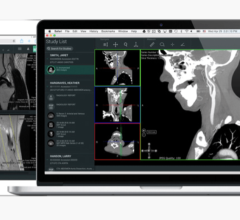
 February 01, 2024
February 01, 2024 
